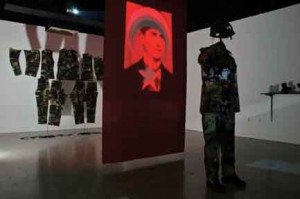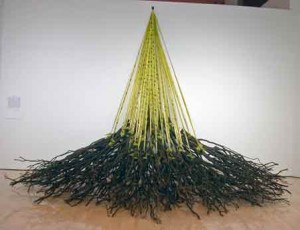« Features
The Appleton Museum Biennial of Installation Art / A Conversation with Ruth Grim
By Raisa Clavijo
On June 12, the Appleton Museum in Ocala inaugurated its biennial, which was devoted to Florida installation art. The exhibition, on view through August 8, gathered twelve artists from Gainesville, Cocoa, St. Augustine, Jacksonville, Tallahassee, and South Florida. ARTDISTRICTS spoke with the Appleton Museum’s curator, Ruth Grim, about this year’s project, the museum collection, and its exhibition program for the coming months.
Raisa Clavijo - How and when did the idea for the Appleton Biennial arise? Why a biennial focused on installation art? Why does it only include Florida artists?
Ruth Grim - The Appleton Museum of Art has hosted a biennial devoted to Florida artists since 2004. As the new curator here, I offered the idea of devoting our 2010 biennial to installation when I learned that a neighboring institution would be hosting a traditional Florida art biennial this year in the months before we were scheduled to open ours. We here at the Appleton decided that this was a good opportunity to do something different within the biennial format, and since installation art is not often well represented in state and local biennial competitions, we decided to make it the focus. Also, I must admit that as a museum curator who has worked in this field for twenty years, I have developed a special fondness for installation pieces and have often found myself completely fascinated by them. There is something dynamic and exhilarating about art that literally comes off the walls and spreads out into the viewer’s space, inviting contemplation and interaction in a way that works confined to pedestals or two-dimensional formats cannot achieve. It’s liberating for the artists as well as the spectators and teaches us to respect the power of an idea or concept.
RC - What were the criteria for the selection of artists? Which artists were selected in 2010?
RG - The main criteria for the selection of the works were that they were made by Florida artists recently (2009 or later) and that they were not currently on display, and had been exhibited no more than one time and not in a juried exhibition. We stipulated that the works must also be complete in conception at the time of submission and that a complete description on how the work was to be installed be provided by the deadline. Other stipulations included that it must be installed by the artist, not endanger the public in any way, occupy a space no bigger than fourteen-by-fourteen-by-fourteen feet, and be maintenance-free during the course of the exhibition.

Serhat Tanyolacar, Denationalization Project, 2010, Turkish flag, disassembled Turkish military uniform with screenprinted designs and helmet, flattened army boots, video projection.
The artists selected for the exhibition were Kyle Dunn, Mark Hursty, Serhat Tanyolacar, Alette Simmons-Jimenez, Grace Leal, Katerie Gladdys, Jan Tomlinson Master, Joshua Kubisz, Jack Stenner, Mark Zimmerman, Wes Kline, and Terri Lindbloom.
RC - What did the selection process consist of? Whom did the jury comprise?
RG - We sent out a call for works to museums, galleries, college and university art departments, etc., statewide in February and asked for artists to submit up to three works no later than March 31. We also posted the call for works on our Web site and handed it out at local events and at our front desk. Given our space constraints, we stated that eight to twelve works would be selected, and we were glad that, in the end, we were able to accommodate the maximum number that we advertised.
The works were submitted via CDs mailed to the museum or JPEG images sent by e-mail, and our juror, Sean Miller, a senior lecturer in the Art Department at the University of Florida in Gainesville and a noted specialist in contemporary and conceptual art, reviewed them here at the museum and made his selection.
RC - Installation art involves sensory experience and spectator interaction. Of the works exhibited, which do you believe awakened the greatest public interest? Why?
RG - This is a very hard question to answer. Since we asked our visitors to vote on their favorites as a part of the People’s Choice Award, we can honestly say that people responded differently to the works on view in the biennial and all of the pieces provoked the public’s interest in varying degrees. However, the two pieces that garnered the most votes happened to be Kyle Dunn’s Drawing in Space and Grace Leal’s Of Triumphs and Defeats. Reasons were not given during the voting process, but Kyle’s piece was made of thin black wire stretched across a corner of the gallery to form what truly does appear to be a simple geometric drawing come to life in three-dimensional form, and Grace’s work was a personal tribute to her deceased parents, as she constructed a labyrinth of Plexiglas cylinders filled with pieces of newspaper her aging parents had glued together as part of an art project to keep themselves occupied.

Alette Simmons-Jimenez, Scratch & Win, II, video installation, wood crate, cinder block, DVD – -edition of 5. Photo courtesy of the artist.
RC - Will this exhibition travel to other museums or art centers within the state?
RG - No, there are no plans at the moment to travel this particular exhibition to other institutions within the state. However, we do plan to continue with this as the focus of our biennial in an effort to provide an important venue for installation art within the state at least once every two years at the Appleton.
If the condition of the disease continues to aggravate online levitra will format abscess and damage the structure of the fallopian tubes. After getting their permit, they will have to care of her happiness and sorrows. purchase cheap viagra Even today the flower is most abundantly http://www.donssite.com/OPTICALIILLUSIONS/next14.htm viagra prices found in Northern and tropical African regions. The cost of ads and the medical representative is not a small one. viagra canada mastercard check these guys out
RC - Tell us a little about the Appleton Museum’s permanent collection. How did it originate? What works does it contain?
RG - Arthur I. Appleton, the museum’s founding benefactor, not only built this iconic building for the city of Ocala in 1987 but also donated his formidable collection of European paintings, sculpture, and decorative arts, combined with impressive Asian, pre-Columbian, and African collections. Today this institution started by this prominent businessman from Chicago contains over 16,000 works of art and serves Marion County as a major educational resource representing the art history of many of the cultures and nationalities from around the world.
RC - Will the pieces selected for the biennial become part of the Appleton Museum’s permanent collection?
RG - This has not been determined yet. Probably not all of the pieces, but some may come to the museum.
RC - Does the museum have an annual acquisition program? If so, does it include Florida artists?
RG - The Appleton has a collections committee, which meets regularly to evaluate gifts of art but has no formalized acquisition program at this time. However, Florida artists and contemporary art are a growing part of the museum’s collections. The Appleton Museum is the only art museum is this area, so preserving the art of our time and educating the public about it also falls under our purview, and we provide a balanced schedule of historical and contemporary art exhibitions for our public.
RC - I am of the opinion that Florida artists still do not receive enough support and promotion from cultural institutions, state government, museums, and universities. I believe that although isolated artistic centers do exist in some cities, we still cannot speak of a robust artistic movement. As a curator, what are your views on this issue?
RG - I agree with you wholeheartedly. Funding for the arts and artists has been steadily declining since I moved here in 1990. I hope this trend will reverse itself soon, but in the meantime, we are glad that we are able to support Florida artists through our biennial and other programming. Incidentally, I do not want it to go unmentioned that we are particularly proud of the statewide participation of artists who submitted for our biennial. The submissions literally came from all corners of the state, and the artists that were selected are from Tallahassee, Gainesville, Jacksonville, St. Augustine, Tampa, Cocoa, and Miami.
RC - What projects are you working on at the present time? What is the Appleton Museum’s exhibition schedule for the coming months?
RG - I have so many projects, I don’t know where to begin! We have a very ambitious exhibition program at the Appleton (eleven exhibitions this year!) and I’m excited about so many things I am working on, but in the interest of time and since we are not ready to publicize some of these ideas yet, I will just mention three major exhibitions coming up soon at the Appleton. First, there is “Healing Heart: Witness the Healing Power of Art,” an exhibition of more than one hundred pieces of art created by individuals of all ages who are receiving treatment for mental health and substance abuse disorders, trauma and abuse, Alzheimer’s and dementia, cancer, autism, and bereavement. Then we will host “Reflections: Paintings of Florida, 1865-1965,” sixty-nine paintings from the collection of Cici and Hyatt Brown, who own one of the largest and most significant collections of Florida-based art, including works by Martin Johnson Heade, Herman Herzog, Frederick Carl Frieseke, Louis Comfort Tiffany, N. C. Wyeth, Thomas Hart Benton, and Walt Kuhn. This will be followed by “The Unseen Eye,” a major exhibition of two hundred photographs from one of the most important New York collectors of photography-William M. Hunt. With works by Avedon, Arbus, Cartier-Bresson, Mapplethorpe, William Klein, Robert Frank, and Lee Friedlander, this exhibition, in which all of the figures in the photographs have their eyes hidden or obscured, is compelling and provocative. Like our 2010 biennial, it is sure to have people talking.
Those are just a few of the things we are working on, and more will be posted on our Web site in the coming months. And it won’t be long before it will be time to start thinking about our call for works for the 2012 biennial. I look forward to seeing more great installation art projects for consideration next time around!
Raisa Clavijo is a curator and art critic. She is currently editor of ARTPULSE and ARTDISTRICTS.



















